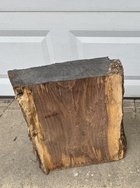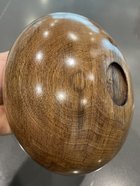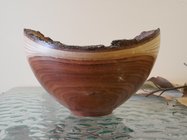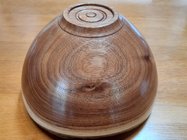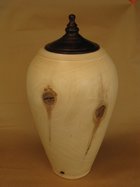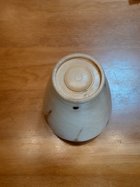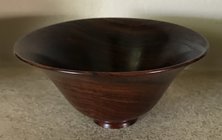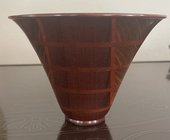-
Beware of Counterfeit Woodturning Tools (click here for details) -
Johnathan Silwones is starting a new AAW chapter, Southern Alleghenies Woodturners, in Johnstown, PA. (click here for details) -
Congratulations to Peter Jacobson for "Red Winged Burl Bowl" being selected as Turning of the Week for April 29, 2024 (click here for details) -
Welcome new registering member. Your username must be your real First and Last name (for example: John Doe). "Screen names" and "handles" are not allowed and your registration will be deleted if you don't use your real name. Also, do not use all caps nor all lower case.
You are using an out of date browser. It may not display this or other websites correctly.
You should upgrade or use an alternative browser.
You should upgrade or use an alternative browser.
How big of a recess?
- Thread starter Patrick Norris
- Start date
- Joined
- Feb 28, 2021
- Messages
- 1,230
- Likes
- 1,088
- Location
- Roulette, PA
- Website
- www.reallyruralwoodworks.com
Dunno how safe it might be, but I turned a 11 inch bowl out of 5 inch thick ash log that I chainsawed just enough to clear the ways on my 12 inch swing HF lathe - Using the ONLY chuck I had at the time, an off-brand dovetailed jaw that uses about 2 inch tenon (But I turned it a bit bigger than 2 inch so as to have enough "meat" to true it up for twice turning) It never came off the lathe or had any real problems - But then with that HF lathe, it's hard to even take an aggressive cut (and I had to just about stand on the lathe frame to hold it in place while roughing the blank to round at 650 RPM, and even then it wanted to walk all over the place until I could get it round enough to stop shaking) Granted, it can be fearsome/scary at that size, but the 2 inch (give or take 1/4 inch) tenon held just fine.
However, if you have larger jaw set (I now have a barracuda jaw set that I can out bigger nearly 4 inch tenons on, so I'd probably use those for another blank of that size) It'd probably be better to go with the bigger jaws.
However, if you have larger jaw set (I now have a barracuda jaw set that I can out bigger nearly 4 inch tenons on, so I'd probably use those for another blank of that size) It'd probably be better to go with the bigger jaws.
Not a fan of using a recess but I would use 100 mm jaws, and 1/4” deep should be plenty.
Goal #1 is to make a very, very well shaped recess that matches the contour of your jaws, which usually have a dovetail angle on the outside
Goal #2 is to have a strong recess with adequate shoulder material so the jaws don't tear out.
Goal #3 is to size the recess just a wee bit larger in diameter than the smallest diameter of your chuck jaws.
Goal #4 is for the recess to correlate with the size of the foot you will have, even if the 'foot' is the outside bottom of the bowl.
If you can cut the blank to a circle on a band saw, to avoid excess mass and make it more balanced, and you have a good recess and light touch with your tools, a 2" recess might work. Using the 30% rule of thumb, your foot should end up about 3". Jaws of 3" jaws will naturally lean toward a foot of 3 1/2", or more.
Like Rusty and the majority of turners in North America, I use a tenon on bowls.
Goal #2 is to have a strong recess with adequate shoulder material so the jaws don't tear out.
Goal #3 is to size the recess just a wee bit larger in diameter than the smallest diameter of your chuck jaws.
Goal #4 is for the recess to correlate with the size of the foot you will have, even if the 'foot' is the outside bottom of the bowl.
If you can cut the blank to a circle on a band saw, to avoid excess mass and make it more balanced, and you have a good recess and light touch with your tools, a 2" recess might work. Using the 30% rule of thumb, your foot should end up about 3". Jaws of 3" jaws will naturally lean toward a foot of 3 1/2", or more.
Like Rusty and the majority of turners in North America, I use a tenon on bowls.
Question is what chuck are you having/using, I have used my Oneway chucks for many years and use the standard Oneway jaws in the recess, if you use dovetail jaws you will need to make the recess fitting those jaws.
A recess is a very safe manner to hold sound wood to turn, but the recess has to be made very nice and clean so the jaws can hold the wood securely.
Here is a typical recess as I make in 90% of my turnings
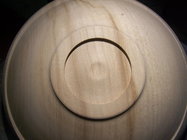
As for size I make a recess typically about 1/3th of the blank size, depending a bit on the shape and size and the shape I will be turning it, and 1/8th to 3/16" that is deep enough, a little deeper does not hurt.
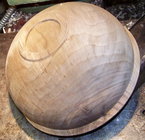
Here is a White Ash held with a recess while turning the inside.
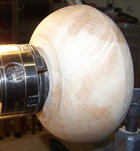
This rough turned Walnut piece is about 15 " and was held with a shallow recess, enough for a experienced turner, just take your time.
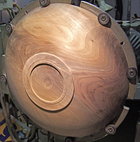
A recess is a very safe manner to hold sound wood to turn, but the recess has to be made very nice and clean so the jaws can hold the wood securely.
Here is a typical recess as I make in 90% of my turnings

As for size I make a recess typically about 1/3th of the blank size, depending a bit on the shape and size and the shape I will be turning it, and 1/8th to 3/16" that is deep enough, a little deeper does not hurt.

Here is a White Ash held with a recess while turning the inside.

This rough turned Walnut piece is about 15 " and was held with a shallow recess, enough for a experienced turner, just take your time.

Perfect Leo! Thank you for the photos and your explanation.Question is what chuck are you having/using, I have used my Oneway chucks for many years and use the standard Oneway jaws in the recess, if you use dovetail jaws you will need to make the recess fitting those jaws.
A recess is a very safe manner to hold sound wood to turn, but the recess has to be made very nice and clean so the jaws can hold the wood securely.
Here is a typical recess as I make in 90% of my turnings
View attachment 60263
As for size I make a recess typically about 1/3th of the blank size, depending a bit on the shape and size and the shape I will be turning it, and 1/8th to 3/16" that is deep enough, a little deeper does not hurt.
View attachment 60264
Here is a White Ash held with a recess while turning the inside.
View attachment 60265
This rough turned Walnut piece is about 15 " and was held with a shallow recess, enough for a experienced turner, just take your time.
View attachment 60267
In addition to the excellent safety suggestions above, you'll want to keep the tailstock up while you hog out the first 25-30% of the inside mass. By that time, the blank will be much lighter and better balanced.
With a recess make sure you don’t tighten too much and cause a split, not an issue with a tenonLike Rusty and the majority of turners in North America, I use a tenon on bowls.
A good source of information
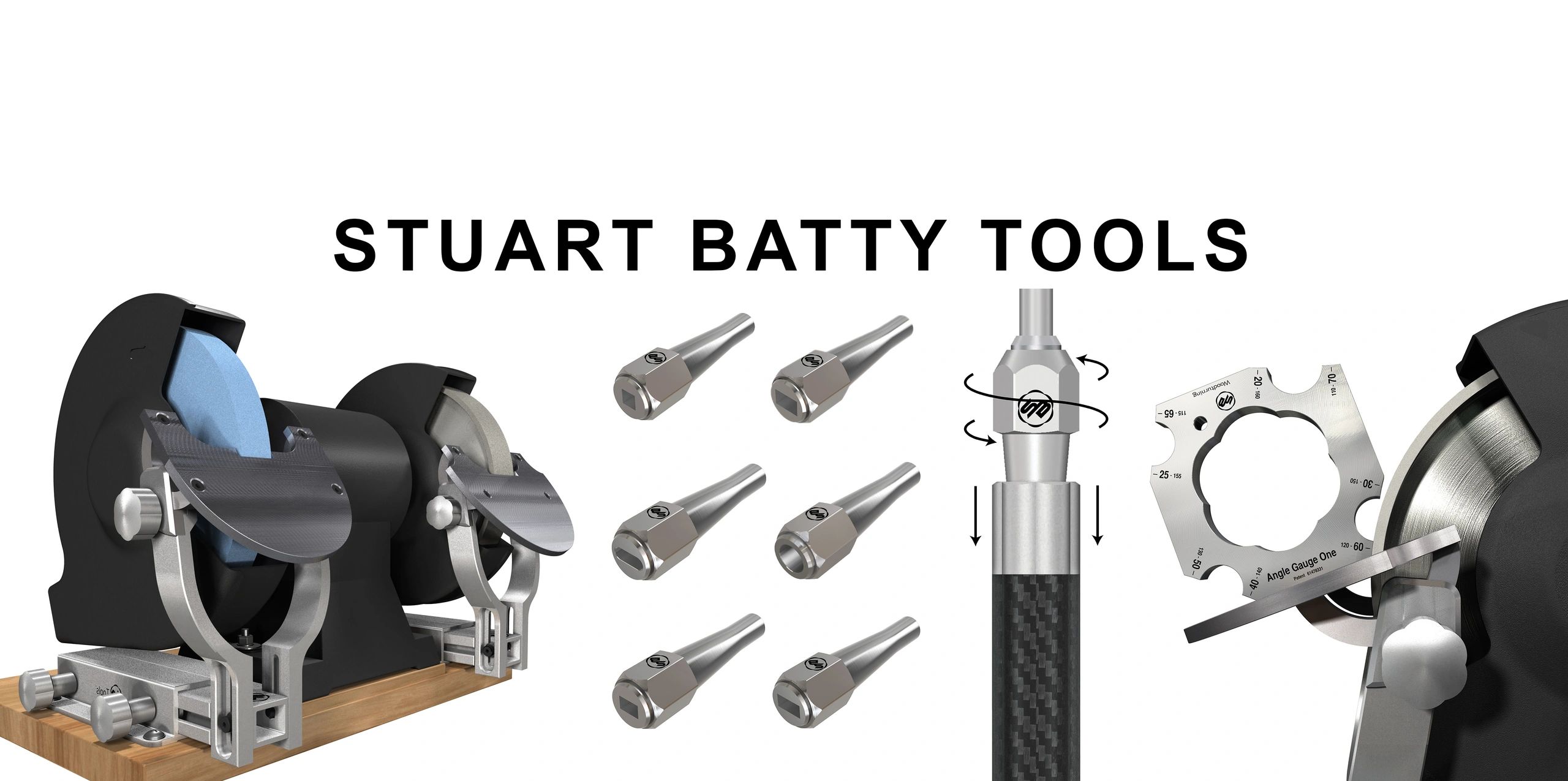
 stuartbattytools.com
stuartbattytools.com
If you scroll down you will locate a 25 minute video

Stuart Batty Tools
If you scroll down you will locate a 25 minute video
7 Fundamentals - Recess Tenons & Preparing Recesses in Bowl Blanks
For a bowl that size, looks to be 3 or so inches thick, my go to recess fits my Vicmark chuck jaws (120 I think) and it measures about 2 5/8 inches wide. I go 1/8 inch deep, and do match as closely as possible the angle of your chuck jaws. 1/4 inch is deeper than you need. I did see Mike Mahoney turn a walnut platter that had a recess that was 1/16 deep. It was dried wood, and that is more shallow than I would go. Now days, I never measure.... I would suggest having at least a 1/2 inch shoulder outside the recess, and this should leave you a nice sized foot for that bowl. If you leave too narrow of a shoulder, you can tighten to the point where you break the wood, or leave so much pressure on it that even a small catch will cause it to fail. With a 3/4 inch shoulder, that is more wood to push against than you will have with a 3 inch tenon. A video I did a long time ago:
View: https://www.youtube.com/watch?v=5KHkkws9lWA
robo hippy
robo hippy
Thank you for all of the help.
Not a fan of using a recess but I would use 100 mm jaws, and 1/4” deep should be plenty.
I don't know if I'm a fan of recesses, but close to 100% of my bowls, platters and hollow forms are 2nd turned or turned from seasoned blanks using a recess. I've been doing it that way since the first scroll chucks became available.
The reason I do it that way is that it eliminates an extra step in the turning process:
- Mount the blank or pre-turned piece on the lathe and turn, sand and polish the outside.
- Remount the bowl/platter/hollow form by its recess and turn, sand and polish the inside.
Remount to remove foot tenon and make final foot- Remove from the lathe.... piece is done!
The other downsize is that it takes a bit more skill to turn out the inside of bowls and hollow forms using a shallow recess without hoiking the piece off the lathe. I had less of that problem with the second 500 pieces I turned that way and since then rarely lose a piece at that stage. If it does come off the lathe at that stage you invariably have to completely re-turn, sand and polish it again, that is if it can be salvaged at all. But, overall I think I'm ahead by having eliminated that extra step.
If trying this, to begin with:
Use deeper recesses until you get the feel for how shallow you can go on the recesses.
Make your recesses as close to the true circle of the jaws sizes you have to spread the forces evenly inside the recess.
Also, position the jaws in the quarter sawn position to reduce the chances of splitting (ie at 45deg from the direction of the grain so the mid point of the jaw, where the max pressure will be exerted, is at 45deg to the grain in crossgrain pieces). Pressure directly out against the sidegrain will make the recess ring more vulnerable, so 45deg is the safest position. Robo Hippy's video also covers those points.
But, I can understand why turners go with outside tenons, especially if they have limited jaw size options available and also still getting up to speed with their turning techniques that reduce the chance of a catch, which will be more readily hoiked off the lathe if held with a fine recess.
PS
- I do use recesses on both side and endgrain pieces.
- I do almost all of my turning outboard, so never use tailstock support.
- My foot rings are not as supported with as much wood compared to some others turners who also use recesses... :~}
Last edited:
Thank you Neil. That is alot of good information. I think I will give it a try.I don't know if I'm a fan of recesses, but close to 100% of my bowls, platters and hollow forms are 2nd turned or turned from seasoned blanks using a recess. I've been doing it that way since the first scroll chucks became available.
The reason I do it that way is that it eliminates an extra step in the turning process:
The downside of this method is that you need many different chuck jaw sizes to get the design proportions right. At last count I have 16 different jaw sizes going from 223mm down to 25mm at true circle on the OD dovetail. Only yesterday I completed a 65mm dovetail jaw size that wasn't commercially available for my chucks, which filled the gap between my 56mm and 72mm jaws.
- Mount the blank or pre-turned piece on the lathe and turn, sand and polish the outside.
- Remount the bowl/platter/hollow form by its recess and turn, sand and polish the inside.
Remount to remove foot tenon and make final foot- Remove from the lathe.... piece is done!
The other downsize is that it takes a bit more skill to turn out the inside of bowls and hollow forms using a shallow recess without hoiking the piece off the lathe. I had less of that problem with the second 500 pieces I turned that way and since then rarely lose a piece at that stage. If it does come off the lathe at that stage you invariably have to completely re-turn, sand and polish it again, that is if it can be salvaged at all. But, overall I think I'm ahead by having eliminated that extra step.
If trying this, to begin with:
Use deeper recesses until you get the feel for how shallow you can go on the recesses.Make your recesses as close to the true circle of the jaws sizes you have to spread the forces evenly inside the recess.Also, position the jaws in the quarter sawn position to reduce the chances of splitting (ie at 45deg from the direction of the grain so the mid point of the jaw, where the max pressure will be exerted, is at 45deg to the grain in crossgrain pieces). Pressure directly out against the sidegrain will make the recess ring more vulnerable, so 45deg is the safest position. Robo Hippy's video also covers those points.
But, I can understand why turners go with outside tenons, especially if they have limited jaw size options available and also still getting up to speed with their turning techniques that reduce the chance of a catch, which will be more readily hoiked off the lathe if held with a fine recess.
PS
- I do use recesses on both side and endgrain pieces.
- I do almost all of my turning outboard, so never use tailstock support.
- My foot rings are not as supported with as much wood compared to some others turners who also use recesses... :~}
I've added an upright of each piece as the photo
from the foot direction make the feet look much bigger than
they actually are from the camera foreshortening.
The first one is crossgrain
and the second is a 12" tall endgrain hollow form
View attachment 60300 View attachment 60301
View attachment 60303 View attachment 60304
Me too, I always use a tenon. Not just for safety but I believe it offers more design options for finishing the foot. I must confess, I didn’t think of this, one of the demonstrators at my club mentioned it.Not a fan of using a recess but I would use 100 mm jaws, and 1/4” deep should be plenty.
I agree, Bill. I always use tenons because they allow for more design options. They also result in a finished turning that shows no evidence of how the item was held on the lathe.
That’s what I do too. I match the tenon for the size of the foot I want. When I make a round bottom bowl I normally use a 50 mm tenon.Me too, I always use a tenon. Not just for safety but I believe it offers more design options for finishing the foot. I must confess, I didn’t think of this, one of the demonstrators at my club mentioned it.
I have been taught that when somebody looks at your bowl they should not be able to tell how it was held onto the lathe. Even when I used a recess I would finish turn the recess not to look like one. I had three thin bowls crack in half while sanding because of the jaws being too tight in the recess. Since I have gone to a tenon I have not lost a bowl.I don't know if I'm a fan of recesses, but close to 100% of my bowls, platters and hollow forms are 2nd turned or turned from seasoned blanks using a recess. I've been doing it that way since the first scroll chucks became available.
The reason I do it that way is that it eliminates an extra step in the turning process:
The downside of this method is that you need many different chuck jaw sizes to get the design proportions right. At last count I have 16 different jaw sizes going from 223mm down to 25mm at true circle on the OD dovetail. Only yesterday I completed a 65mm dovetail jaw size that wasn't commercially available for my chucks, which filled the gap between my 56mm and 72mm jaws.
- Mount the blank or pre-turned piece on the lathe and turn, sand and polish the outside.
- Remount the bowl/platter/hollow form by its recess and turn, sand and polish the inside.
Remount to remove foot tenon and make final foot- Remove from the lathe.... piece is done!
The other downsize is that it takes a bit more skill to turn out the inside of bowls and hollow forms using a shallow recess without hoiking the piece off the lathe. I had less of that problem with the second 500 pieces I turned that way and since then rarely lose a piece at that stage. If it does come off the lathe at that stage you invariably have to completely re-turn, sand and polish it again, that is if it can be salvaged at all. But, overall I think I'm ahead by having eliminated that extra step.
If trying this, to begin with:
Use deeper recesses until you get the feel for how shallow you can go on the recesses.Make your recesses as close to the true circle of the jaws sizes you have to spread the forces evenly inside the recess.Also, position the jaws in the quarter sawn position to reduce the chances of splitting (ie at 45deg from the direction of the grain so the mid point of the jaw, where the max pressure will be exerted, is at 45deg to the grain in crossgrain pieces). Pressure directly out against the sidegrain will make the recess ring more vulnerable, so 45deg is the safest position. Robo Hippy's video also covers those points.
But, I can understand why turners go with outside tenons, especially if they have limited jaw size options available and also still getting up to speed with their turning techniques that reduce the chance of a catch, which will be more readily hoiked off the lathe if held with a fine recess.
PS
- I do use recesses on both side and endgrain pieces.
- I do almost all of my turning outboard, so never use tailstock support.
- My foot rings are not as supported with as much wood compared to some others turners who also use recesses... :~}
I've added an upright of each piece as the photo
from the foot direction make the feet look much bigger than
they actually are from the camera foreshortening.
The first one is crossgrain
and the second is a 12" tall endgrain hollow form
View attachment 60300 View attachment 60301
View attachment 60303 View attachment 60304
For me it’s tenons all the way, but the question you ask might not be the right one because it really depends on the jaws you have. You need to cut your recess or tenon to match the jaws for best grip. A 10/11” bowl isn’t that big so as long as you’re not too prone to massive catches a standard set of jaws should be fine (Axminster C jaws grip 56mm tenon and a 69mm recess)
95% or more of my bowl turnings are made with a recess rather than a tenon, I was turning a long time ago and found a recess held better than a tenon, still my opinion.
As for design options, you show me where a tenon has more options, just BS IMO, I just pulled 16 pictures of bowls that I turned and do have pictures of the bottoms, you will be hard pushed to tell if they where turned with a tenon or recess
There are bigger problems for many here that can't even get to turn a piece without splits and checks, rough tearout etc.,never mind being not able to tell that the heavy ham-fisted turner ripped a bowl with a recess out of the chuck, still more likely to be able to be remounted than when a tenon broke off, just like Stuart Batty showed in his video.
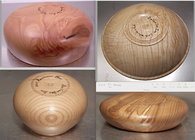
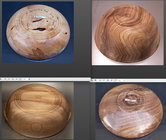
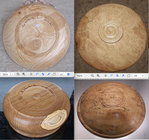
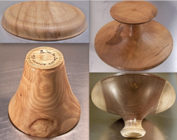
As for design options, you show me where a tenon has more options, just BS IMO, I just pulled 16 pictures of bowls that I turned and do have pictures of the bottoms, you will be hard pushed to tell if they where turned with a tenon or recess
There are bigger problems for many here that can't even get to turn a piece without splits and checks, rough tearout etc.,never mind being not able to tell that the heavy ham-fisted turner ripped a bowl with a recess out of the chuck, still more likely to be able to be remounted than when a tenon broke off, just like Stuart Batty showed in his video.




I agree with you I don't like seeing how the bowl was heldI agree, Bill. I always use tenons because they allow for more design options. They also result in a finished turning that shows no evidence of how the item was held on the lathe.
Two comments:
1) As a hollow-former I always use a tenon and keep the annular ring of the base under 4". I would think a 3"-dia recess maybe 1/8" deep would allow a tenon to be glued on your blank. WEST G-Flex is a great choice for epoxy - especially if the wood and tenon are not bone dry. And remember, gluing an axial grain tenon into a radial grain blank can be challenging - a Baltic birch tenon with a couple of pegs to prevent layer separation might make sense
2) The concise one-line problem statement allowed the above posts to be spot-on.
1) As a hollow-former I always use a tenon and keep the annular ring of the base under 4". I would think a 3"-dia recess maybe 1/8" deep would allow a tenon to be glued on your blank. WEST G-Flex is a great choice for epoxy - especially if the wood and tenon are not bone dry. And remember, gluing an axial grain tenon into a radial grain blank can be challenging - a Baltic birch tenon with a couple of pegs to prevent layer separation might make sense
2) The concise one-line problem statement allowed the above posts to be spot-on.
Yes that does make sense John, or one would end up whit a hole rather than a hold.I have glued pieces on with a "recess" that was less than 1/16", basically to just hold the added piece to stay in place, takes hard ly anything the remove it later, don't even have to glue the whole "recess" as this makes for a strong hold.Two comments:
1) As a hollow-former I always use a tenon and keep the annular ring of the base under 4". I would think a 3"-dia recess maybe 1/8" deep would allow a tenon to be glued on your blank. WEST G-Flex is a great choice for epoxy - especially if the wood and tenon are not bone dry. And remember, gluing an axial grain tenon into a radial grain blank can be challenging - a Baltic birch tenon with a couple of pegs to prevent layer separation might make sense
2) The concise one-line problem statement allowed the above posts to be spot-on.
As I showed it is very easy to turn the "Foot" without telltale "How it was held"
It seems we’ve had the recess/tenon debate on here before. I agree with Mark Wollschlagers comment:
 www.aawforum.org
www.aawforum.org
Tenon wins 5/4
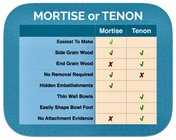
“Also, because of their ease of later alterations, tenons can be reshaped to match almost any design or final look needed. The portion of the tenon gripped by the wood chuck can also be included in the final base.”

 turnawoodbowl.com
turnawoodbowl.com
I suppose it’s a personal thing and what you get used to. I like to see an elegant foot on a bowl and believe that’s easier to achieve if you start with a Tenon.
Recess or tenon
My first post in this forum. I've been posting in the getting started forum so you guys know I'm new and appreciate all the help I got there. I've turned 3x3 by two feet long spindles for a couple of days with the spindle gouge and skew. Yesterday I add 300 pounds to the bottom of my lathe and...
Tenon wins 5/4

“Also, because of their ease of later alterations, tenons can be reshaped to match almost any design or final look needed. The portion of the tenon gripped by the wood chuck can also be included in the final base.”

Wood Bowl Mortise or Tenon – Which is Best? - Turn A Wood Bowl
Mortise or tenon, that is the question when turning or making a wood bowl. For some, there is no preference, for others, it’s either mortise or tenon, but…
I suppose it’s a personal thing and what you get used to. I like to see an elegant foot on a bowl and believe that’s easier to achieve if you start with a Tenon.
Last edited:
I have been taught that when somebody looks at your bowl they should not be able to tell how it was held onto the lathe.
Having not been taught woodturning (there was no one to 'teach' me when I began woodturning 55yrs ago) I never got that message and when I started to read and hear about it later on I never got it. I just relied on my art and design background to guide me on what I thought worked aesthetically.
Tracing back later through the history on this 'dictum' in publications like NZ's Faceplate magazine it began well before the modern chucks came into common use, starting with the screw holes left in the bottom of bowls from attaching them to faceplates. I can understand why we disguised those rough screw holes with stickers and felt pads, but that then morphed into an obsession for disguising any trace of how a piece was held on the lathe with the later chucks that left little to no marks on the finished piece. I'm all for aesthetic considerations in woodturning, but this obsession with 'immaculate' creation is like an inferiority complex.
Allied crafts like ceramics, where I was also a teacher and practitioner for some time, holds a higher status in state/provincial/national art galleries, yet it is far more relaxed about the remaining evidence of how a piece was made. In fact, the first thing a master potter will do when picking up a piece from another artisan is turn it upside down to read how a piece was made and to see the evidence of the skill of its maker.
Baffling viewers and potential buyers on how a piece was made deflects from the appreciation of the aesthetics of the piece, IMO.
I suppose it’s a personal thing and what you get used to. I like to see an elegant foot on a bowl and believe that’s easier to achieve if you start with a Tenon.
I'm with you on liking to see elegant feet, Bill, and they are certainly more challenging when held with a recesses as it leaves little wood to support the piece.
Elegant feet are definitely easier to achieve for most turners using a tenon. Also, the extra time required to remount and turn off a tenon and make a finished foot is inconsequential for most turners.
I threw my experience into the discussion for the benefit of any turner who might want to increase their production rate, for whatever reason, and would like to consider doing it the way I do. I know of only a few other turners who do it mostly the same way and the pool of expertise on this is becoming less readily available, so I throw in my experience whenever the topic comes up.
And, I would much prefer to see elegant feet than knowing that a piece was made this way or the other!
That was an interesting read but I’ve highlighted one sentence from it, this is exactly what most turners do, but the skill of the maker is to leave the base as neat as possible. I have no real problem with recesses as such, it’s just when they are unnecessarily big and untidy. A properly removed tenon doesn’t take long and, in my opinion, leaves a superior appearance on the base of a bowl.In fact, the first thing a master potter will do when picking up a piece from another artisan is turn it upside down to read how a piece was made and to see the evidence of the skill of its maker.
I fully agree with your sentiment. I was never taught wood turning either but I’ve picked up a lot since joining a club. It was at the club that a demonstrator spoke about using a tenon rather than recess. I think though that for those starting out a recess is seen as an easier option, particularly when finishing off the base. Once you realise a tenon offers more possibilities, removing a small amount of extra wood is neither here nor there.I'm with you on liking to see elegant feet, Bill, and they are certainly more challenging when held with a recesses as it leaves little wood to support the piece.
Elegant feet are definitely easier to achieve for most turners using a tenon. Also, the extra time required to remount and turn off a tenon and make a finished foot is inconsequential for most turners.
I threw my experience into the discussion for the benefit of any turner who might want to increase their production rate, for whatever reason, and would like to consider doing it the way I do. I know of only a few other turners who do it mostly the same way and the pool of expertise on this is becoming less readily available, so I throw in my experience whenever the topic comes up.
And, I would much prefer to see elegant feet than knowing that a piece was made this way or the other!
I have never been taught woodturning either. I have been told by friends that teach classes that by removing the tenon or recess makes the piece look more professional. I have to agree with that. Look at pieces made by the big names out there and I don’t think you will find a tenon or recess left on any of their finished work.
Bill's scorecard or chart above suggests that recesses are easier to make. I don't agree. Both a tenon and a recess need to be properly made to get a secure hold, so they should probably be scored as the same, but for me, the tail stock gets in the way of making a proper recess. Mounted between centers, there's no getting around the tail stock, and on a screw I worry if it will hold well and safely. A faceplate would be pretty reliable, but I rarely use them. YMMV
Bert Marsh would leave a tenon on occasion. So does Michael Mode. Most don’t.I don’t think you will find a tenon or recess left on any of their finished work.
Attachments
As this question has come up a time or two, so in 2009 I did post a picture to a recess tool that can be used with the tailstock (I do not have a tailstock on my outboard setup, and start with a faceplate).Bill's scorecard or chart above suggests that recesses are easier to make. I don't agree. Both a tenon and a recess need to be properly made to get a secure hold, so they should probably be scored as the same, but for me, the tail stock gets in the way of making a proper recess. Mounted between centers, there's no getting around the tail stock, and on a screw I worry if it will hold well and safely. A faceplate would be pretty reliable, but I rarely use them. YMMV
So this was a quick ground tool to show what you would need, one could certainly make a nicer one from an extra scraper,
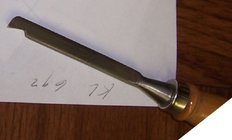
bought mine, a dovetail scraper, and works well for mortise and tenon. https://www.leevalley.com/en-us/shop/tools/hand-tools/turning-tools/46297-dovetail-scraper?item=35B0104&utm_source=free_google_shopping&utm_medium=organic&utm_campaign=shopping_feed&utm_campaign=USA|PLA|PMax|Tools|MidPriceTier&gad_source=1&gclid=CjwKCAiA_aGuBhACEiwAly57McyIxmUdUXnAtyHptlCojU-bJfv2xpQWRQeF4HXUa88M5RMzvcz16hoCmtkQAvD_BwEone could certainly make a nicer one
Looks like you did not get my simple tools use as a recess scraper when the tailstock is in the way.bought mine, a dovetail scraper, and works well for mortise and tenon. https://www.leevalley.com/en-us/shop/tools/hand-tools/turning-tools/46297-dovetail-scraper?item=35B0104&utm_source=free_google_shopping&utm_medium=organic&utm_campaign=shopping_feed&utm_campaign=USA|PLA|PMax|Tools|MidPriceTier&gad_source=1&gclid=CjwKCAiA_aGuBhACEiwAly57McyIxmUdUXnAtyHptlCojU-bJfv2xpQWRQeF4HXUa88M5RMzvcz16hoCmtkQAvD_BwE
Here is a better picture of one in use.
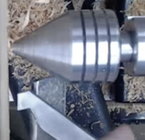
I use a tenon almost exclusively but this seems like one of those things that woodturners say, when the reality is 99 percent of people who buy something have no idea that the foot on the bottom was a recess that was held in a 4 jaw expanding chuck.I have never been taught woodturning either. I have been told by friends that teach classes that by removing the tenon or recess makes the piece look more professional. I have to agree with that. Look at pieces made by the big names out there and I don’t think you will find a tenon or recess left on any of their finished work.
I sold my bowls at craft shows for over 30 years. The only people that seem to care about 'how the bowl was mounted' are other turners. That whole concept baffles me. Like, there are no real mysteries about mounting a bowl on a lathe, so what difference does it really make? None in my book.
robo hippy
robo hippy
I use both. I decide which side (face) of the blank will be the top of the bowl. I find and mark the center. I then use my tailstock to jamb the blank against my chuck jaws. I true up the blank and turn a tenon on the top( tailstock side) of the blank reverse it and turn and finish he outside and bottom of the bowl. Mostly I use a dovetail recess on the bottom but if the design calls for it I’ll use a tenon.
I’ve found tenons and recesses to fail mostly from “operator error” but sometimes from wood failure.
another thought about tenon and recess size.
perfect tenon on a twice turned bowl leaves no room to resize the tenon.
The perfect size tenon is for the maximum gripping power of the chuck. All chuck manufacturers list the range of sizes that their specific jaws will hold both inside and outside stay within these ranges ranges and you should be fine.
@Leo Van Der Loo mentioned ”ham fisted“. This has been a large problem for me. Snug for me is over tightened to some and not tight enough for others. If your tenon tares off during turning was the chuck to tight ,not tight enough, tenon not size perfectly caused by a nasty catch, all of the above or just plain dumb ass?
I have personally Ben guilty of all of the above.
I own, among others, an Easy Wood Tools chuck the jaws for this chuck are cast not machined this means that wh n the chuck is closed the jaws form a perfect circle.
so how do I size my tenon so that I can get maximum holding power.
I’ve found tenons and recesses to fail mostly from “operator error” but sometimes from wood failure.
another thought about tenon and recess size.
perfect tenon on a twice turned bowl leaves no room to resize the tenon.
The perfect size tenon is for the maximum gripping power of the chuck. All chuck manufacturers list the range of sizes that their specific jaws will hold both inside and outside stay within these ranges ranges and you should be fine.
@Leo Van Der Loo mentioned ”ham fisted“. This has been a large problem for me. Snug for me is over tightened to some and not tight enough for others. If your tenon tares off during turning was the chuck to tight ,not tight enough, tenon not size perfectly caused by a nasty catch, all of the above or just plain dumb ass?
I have personally Ben guilty of all of the above.
I own, among others, an Easy Wood Tools chuck the jaws for this chuck are cast not machined this means that wh n the chuck is closed the jaws form a perfect circle.
so how do I size my tenon so that I can get maximum holding power.
No mysteries just a nicely finished bottom or one that looks like they didn’t care.I sold my bowls at craft shows for over 30 years. The only people that seem to care about 'how the bowl was mounted' are other turners. That whole concept baffles me. Like, there are no real mysteries about mounting a bowl on a lathe, so what difference does it really make? None in my book.
robo hippy
A good tenon stock might be to do a glue-up creating a 3"x3"x12" blank of Baltic birch, turn it to a dowel, and then cut the needed amount on a chop-saw when you need a tenon. That way it wouldn't be all end-grain being glued to the side grain bottom.
Wasting away baltic birch is painful but not as much so as a bowl coming off.
Wasting away baltic birch is painful but not as much so as a bowl coming off.
No, I did not. That’s very cool.Looks like you did not get my simple tools use as a recess scraper when the tailstock is in the way.
Here is a better picture of one in use.
View attachment 60388

